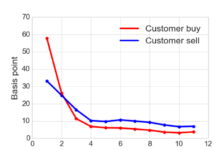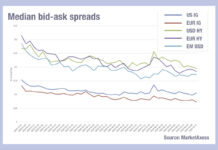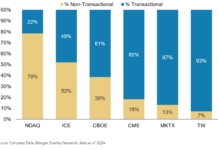
The DESK talks with Steve Toland, co-Founder of TransFICC about developments in fixed income workflow automation, what factors are driving this and why this is top of everyone’s agenda. He also comments on new regulatory changes which will define how fixed income markets and participants evolve electronically over the coming year.
Workflow automation is a key industry trend. How far has the market progressed with automation?
Workflow automation is just getting started in fixed income. In rates, connectivity and auto negotiation is already well serviced by technology, but in less liquid assets and more complex workflows, the market is still dominated by manual processes.
Credit venues have seen a marked increase in all-to-all (A2A) trading volumes over the past year, and the growth of this protocol is compounding the need for liquidity providers to autoquote RFQs to clients.
But dealer-to-client (D2C) Credit trading venues each support multiple RFQ negotiation workflows, and all are different, making it difficult for banks to build automated negotiation systems to respond to client RFQs. It is a complex and time-consuming process to automate as all state transitions need to be mapped, codified, tested, and maintained.
The good news is that many of these workflows can now be automated, and tools to access these pools of liquidity for both liquidity providers and the buy-side have evolved. The growth of A2A trading is continuing to blur lines between the role of price makers and takers.
What are clients asking for in terms of increasing workflow automation?
In a recent Greenwich Coalition survey of buy-side clients in the US and Europe, auto-quoting topped the list of what corporate bond investors would like their liquidity providers to focus on next, particularly in less liquid credit bonds.
For banks providing liquidity, a few of our dealer clients have identified the need to automate small value client ticket requests.
Banks often receive more than 10,000 RFQs a day and 80% of these are smaller in size than USD500,000. Although small in value, the volume of small RFQs is growing and dealers are looking to automate these RFQs to increase efficiency, reduce client waiting time, and enable trading desks to focus on larger deal sizes.
Banks cannot manage this volume unless they automate and extend auto-quote capabilities. Automation is becoming essential, not just a nice to have.
How is TransFICC satisfying that demand?
We have just launched TransACT (Automated Client Trading) for credit and rates eTrading. This new service automates request for quote (RFQ) negotiation workflows for dealers trading on all major D2C venues.
All that is required to integrate with TransACT is for dealers to provide a price stream and an execute/reject instruction for a given RFQ. This is done using a simple API accessible via web socket.
TransACT manages all other aspects of the RFQ negotiation. TransFICC sends a request to the bank’s pricer with venue, client, instrument and size information. If the dealer’s Pricer application quotes, TransFICC then completes the negotiation on the bank’s instruction.
What are the benefits of TransACT?
Dealers can significantly improve workflow efficiency, and increase their available liquidity pool by capturing more tickets, while also improving the service they offer to clients. Automation enables them to accept the trades they want and reject those they don’t.
The only requirement is to have a pricer, as TransACT is provided with the code, support, and security out of the box. As a result the service can go live quickly, with limited resource requirements on the dealer’s side. What used to take months or years for a bank to deploy has been reduced to a few weeks.
Clients also benefit. RFQ response times improve and more tickets can be priced.
How will regulatory changes impact automation in the fixed income market?
Automation has clear benefits in solving the business problem in fixed income, with emphasis on access to fragmented liquidity, simplified business operations and better client service. But automation has to work hand in hand with regulation and compliance.
The regulatory environment is about to become significantly more stringent with the implementation of DORA (Digital Operational Resilience Act) in January 2025.
The new regulatory standards will compel financial institutions to set up and maintain a dedicated ICT third party risk strategy, implement comprehensive business continuity policies and a management process to monitor ICT related incidents – all of which will need to be periodically tested.
Perhaps the most significant development, will be the classification of critical third-party service providers. Those vendors which regulators deem to represent systemic risk in the EU, due to the number of financial institutions they serve and functions they perform, will fall under direct regulatory oversight of supervisory authorities.
At TransFICC, our venue API translation product and eTrading platform for IRS and credit bonds are resiliency tested daily and full DR fail over processes are in place on our own global network with 5 physical data centres across the EU and US. These features significantly reduce ICT risk and ensure institutions can comply with the new Regulatory Technical Standards.
How will Financial Institutions adapt their vendor strategy in light of DORA?
Within DORA, there is increased emphasis in the recently published regulatory technical standards (RTS) for substitutability of vendors and exit strategies for institutions reliant on one service provider.
Looking forward, we expect to see institutions adopting a modular approach to their technology stack and using more than one vendor for the same functions, particularly where the function supported is critical. One of the objectives of DORA regulation is to avoid concentration risk on vendors and ensure financial institutions are not locked in to one provider.
©Markets Media Europe 2023






















